HMI IN SCADA
As the industrial landscape rapidly changes, companies that embrace modern HMI SCADA and digital transformation will be able to keep up with the pace of change, meet challenges in management and operations, and stay competitive. HMI SCADA software helps run industrial plants by providing operators with guidance to make critical decisions.
A few examples of technological innovation that is changing the industrial landscape are: cheap sensors, a high-speed telecom infrastructure, unprecedented computation power, and mobile touch interfaces. With all these features available to us today, it's no wonder our society is evolving in such a way.
Many companies are now having to deal with a large number of retirements out of older employees with deep knowledge and expertise. These older workers are being replaced by younger people who aren't as knowledgeable, but also have digital skills that would be hard for older generations to learn.
Suppliers have an opportunity to help companies cope with the technological developments in a world that is becoming increasingly automated. The first step is implementing a modern HMI.
What is a HMI SCADA?
An HMI SCADA is a type of digital control software that allows operators to monitor and control many operations at once. It uses data from many sources to provide a graphical user interface on screen that facilitates easier execution of processes and tasks. You can work from a screen, mobile device, or any PC connected to the control network. All you need is a web browser.
Human-Machine Interface (HMI) is a system that has been designed to provide a human operator with the information they need to improve operational performance. Mobile visualization such as tablets or laptops, and an operating system at HMI central will allow these operators to visualize data and manage devices, anywhere, anytime.
How does HMI SCADA work?
HMI SCADA systems collect data from RTUs and PLCs, presenting it to operators in a format they can understand and act upon. These systems enable real-time monitoring of machinery, allowing operators to react quickly. Additionally, HMI SCADA interfaces can be connected to data historians for analyzing historical trends. By leveraging these technologies, users can unlock the value of their data, leading to improved operational performance and cost reduction. Modern HMI SCADA systems provide a high-productivity development and visualization environment, offering faster development, advanced tools, and capabilities throughout the plant. This empowers users to maximize the potential of their data and achieve better outcomes.
The Industrial Automation Outlook
The modern SCADA system enables guided steps for operators, offers remote monitoring and mobility, and supports interactions between machines and humans with data insights. HMI and SCADA solutions provide oversight, control, and visualization of all aspects of a business, allowing operators to focus on critical tasks. With HMI SCADA, operators can access reliable data, customize workflows, and improve efficiency. Engineers benefit from faster innovation and reduced time spent on error tracking. Overall, HMI SCADA improves productivity and speeds up critical information retrieval.
HMI SCADA in Use
HMI SCADA systems have revolutionized industrial operations by providing real-time data visualization and control capabilities. They are widely used in various industries such as manufacturing, power generation, infrastructure, and building automation. The integration of HMI and SCADA brings numerous benefits, including increased uptime, efficiency, and supply chain optimization.
One of the key advantages of HMI SCADA systems is their ability to provide operators with real-time data and insights. Through intuitive graphical user interfaces, operators can easily monitor machines, processes, and overall plant operations. They can track critical parameters, identify anomalies, and make informed decisions to ensure smooth functioning.
These systems also enable centralized control over multiple machines and processes, allowing for remote monitoring and adjustments. This enhances operational efficiency, reduces the need for physical presence, and facilitates faster response times.
HMI SCADA systems incorporate data historians, which store and analyze historical data for process optimization and performance evaluation. By analyzing past trends, operators can identify areas for improvement and implement predictive maintenance strategies.
Moreover, HMI SCADA systems are highly adaptable and customizable to meet industry-specific requirements. They can easily integrate with other software applications, enhancing data exchange and communication between different departments within an organization.
Cybersecurity is a significant concern for industrial systems, and HMI SCADA systems address this by incorporating robust security measures. Secure communication protocols, access controls, and user authentication mechanisms safeguard the system from unauthorized access and data breaches.
As industries embrace Industry 4.0 and the Industrial Internet of Things (IIoT), HMI SCADA systems are driving digital transformation. The integration of advanced technologies such as AI and machine learning enables predictive analytics and autonomous decision-making, further enhancing efficiency and performance.
In addition to core functionalities, HMI SCADA systems offer features like comprehensive reporting and data visualization, scalability to accommodate different operational needs, collaboration among stakeholders, and energy efficiency monitoring.
Furthermore, these systems support proactive maintenance and fault detection, minimizing downtime and equipment damage. They also leverage mobile devices for remote accessibility and enable data integration with other systems and devices, improving operational visibility and decision-making.
In conclusion, HMI SCADA systems play a crucial role in modern industrial operations. They empower operators to monitor, control, and optimize processes effectively, leading to improved productivity, reduced downtime, and operational excellence. With advancements in technology, HMI SCADA systems are evolving to meet the demands of smart manufacturing and Industry 4.0, ensuring competitiveness in the rapidly evolving industrial landscape.
You might also like



